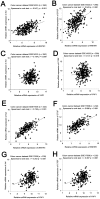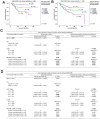TAZ expression as a prognostic indicator in colorectal cancer
- PMID: 23372686
- PMCID: PMC3553150
- DOI: 10.1371/journal.pone.0054211
TAZ expression as a prognostic indicator in colorectal cancer
Erratum in
-
Correction: TAZ Expression as a Prognostic Indicator in Colorectal Cancer.PLoS One. 2021 Apr 8;16(4):e0250187. doi: 10.1371/journal.pone.0250187. eCollection 2021. PLoS One. 2021. PMID: 33831107 Free PMC article.
Abstract
The Hippo pathway restricts the activity of transcriptional coactivators TAZ (WWTR1) and YAP. TAZ and YAP are reported to be overexpressed in various cancers, however, their prognostic significance in colorectal cancers remains unstudied. The expression levels of TAZ and YAP, and their downstream transcriptional targets, AXL and CTGF, were extracted from two independent colon cancer patient datasets available in the Gene Expression Omnibus database, totaling 522 patients. We found that mRNA expressions of both TAZ and YAP were positively correlated with those of AXL and CTGF (p<0.05). High level mRNA expression of TAZ, AXL or CTGF significantly correlated with shorter survival. Importantly, patients co-overexpressing all 3 genes had a significantly shorter survival time, and combinatorial expression of these 3 genes was an independent predictor for survival. The downstream target genes for TAZ-AXL-CTGF overexpression were identified by Java application MyStats. Interestingly, genes that are associated with colon cancer progression (ANTXR1, EFEMP2, SULF1, TAGLN, VCAN, ZEB1 and ZEB2) were upregulated in patients co-overexpressing TAZ-AXL-CTGF. This TAZ-AXL-CTGF gene expression signature (GES) was then applied to Connectivity Map to identify small molecules that could potentially be utilized to reverse this GES. Of the top 20 small molecules identified by connectivity map, amiloride (a potassium sparing diuretic), and tretinoin (all-trans retinoic acid) have shown therapeutic promise in inhibition of colon cancer cell growth. Using MyStats, we found that low level expression of either ANO1 or SQLE were associated with a better prognosis in patients who co-overexpressed TAZ-AXL-CTGF, and that ANO1 was an independent predictor of survival together with TAZ-AXL-CTGF. Finally, we confirmed that TAZ regulates Axl, and plays an important role in clonogenicity and non-adherent growth in vitro and tumor formation in vivo. These data suggest that TAZ could be a therapeutic target for the treatment of colon cancer.
Conflict of interest statement
Figures







Similar articles
-
Association between AXL, Hippo Transducers, and Survival Outcomes in Male Breast Cancer.J Cell Physiol. 2017 Aug;232(8):2246-2252. doi: 10.1002/jcp.25745. Epub 2017 Mar 3. J Cell Physiol. 2017. PMID: 27987320
-
Association between the expression levels of TAZ, AXL and CTGF and clinicopathological parameters in patients with colon cancer.Oncol Lett. 2016 Feb;11(2):1223-1229. doi: 10.3892/ol.2015.3999. Epub 2015 Dec 3. Oncol Lett. 2016. PMID: 26893723 Free PMC article.
-
Overexpression of YAP and TAZ is an independent predictor of prognosis in colorectal cancer and related to the proliferation and metastasis of colon cancer cells.PLoS One. 2013 Jun 10;8(6):e65539. doi: 10.1371/journal.pone.0065539. Print 2013. PLoS One. 2013. Retraction in: PLoS One. 2023 Feb 7;18(2):e0281614. doi: 10.1371/journal.pone.0281614. PMID: 23762387 Free PMC article. Retracted.
-
New twists in the AXL(e) of tumor progression.Sci Signal. 2016 Oct 4;9(448):fs14. doi: 10.1126/scisignal.aai7619. Sci Signal. 2016. PMID: 27703029 Review.
-
DNA binding partners of YAP/TAZ.BMB Rep. 2018 Mar;51(3):126-133. doi: 10.5483/bmbrep.2018.51.3.015. BMB Rep. 2018. PMID: 29366442 Free PMC article. Review.
Cited by
-
Cholesterol Metabolic Reprogramming in Cancer and Its Pharmacological Modulation as Therapeutic Strategy.Front Oncol. 2021 May 24;11:682911. doi: 10.3389/fonc.2021.682911. eCollection 2021. Front Oncol. 2021. PMID: 34109128 Free PMC article. Review.
-
Targeting the Hippo Pathway in Gastric Cancer and Other Malignancies in the Digestive System: From Bench to Bedside.Biomedicines. 2022 Oct 8;10(10):2512. doi: 10.3390/biomedicines10102512. Biomedicines. 2022. PMID: 36289774 Free PMC article. Review.
-
The Hippo Pathway Effector YAP1 Regulates Intestinal Epithelial Cell Differentiation.Cells. 2020 Aug 13;9(8):1895. doi: 10.3390/cells9081895. Cells. 2020. PMID: 32823612 Free PMC article.
-
LINC01413/hnRNP-K/ZEB1 Axis Accelerates Cell Proliferation and EMT in Colorectal Cancer via Inducing YAP1/TAZ1 Translocation.Mol Ther Nucleic Acids. 2020 Mar 6;19:546-561. doi: 10.1016/j.omtn.2019.11.027. Epub 2019 Nov 29. Mol Ther Nucleic Acids. 2020. PMID: 31927328 Free PMC article.
-
BRCA-Monet: a breast cancer specific drug treatment mode-of-action network for treatment effective prediction using large scale microarray database.BMC Syst Biol. 2013;7 Suppl 5(Suppl 5):S5. doi: 10.1186/1752-0509-7-S5-S5. Epub 2013 Dec 9. BMC Syst Biol. 2013. PMID: 24564956 Free PMC article.
References
Publication types
MeSH terms
Substances
LinkOut - more resources
Full Text Sources
Other Literature Sources
Medical
Research Materials
Miscellaneous

